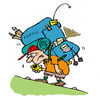
Nibble, nibble like a mouse. Who’s that nibbling at my house?
It was a thrill I’ll never forget—my second-grade debut as the witch in “Hansel and Gretel.” Apparently, I nailed the part; family lore has it that my teacher prophesied to my mother that I was going to be an actress. Well, not quite. Not professionally, anyway. My mother,Who is the real me? of blessed memory, firmly nixed acting as a career option for me (wise on her part, I eventually realized), but the skill of being able to act like someone other than myself was particularly advantageous to me in my youth.
The only problem was that it raised a teeny-tiny, hole-in-my-soul-sized question: Who is the real me?
It was a huge relief to learn that, as a Jew, I am a complex amalgam of physical and spiritual. And the whole point of my being put into this world is to utilize, transform and thereby refine my basic physical self into someone who emanates G‑dliness. There’s nothing inherently “good” or “bad” about my nature; it’s all about how I utilize it.
Of course, I didn’t learn anything about this growing up in my non-religious shtetl in Pittsburgh, and once I started learning about G‑dly behavior, I sometimes regretted my past, pondering how I would have “acted” had I been raised differently.
The good news about being raised in a world of spiritual darkness is that every day of light is one more day that this darkness is behind me. My childhood wasn’t terrible by a long shot—my basic needs were met—but without moral clarity, especially outside the home, it was survival of the fittest. And my world was a jungle.
When I became observant, I asked G‑d for general forgiveness for all the things I did in this survival mode. I’m not talking only about the fact that I ate bacon burgers (because everyone around me did). I’m talking about the way my friends and I treated some of the girls who were judged by the group, and deemed unfit to be part of it. Oh, I was never secure in the group myself, having learned about betrayal in a third-grade Valentine from a “friend” who wrote I hate you on the back. But being a part of the group was essential to social survival.
There were those who tried to jolt us into better behavior—our grade-school science teacher harangued us as “stupid little girls who care about stupid little things”—but why would we listen to her? First of all, she was old. She taught us about evolution; didn’t we understand the world better than she did? She taught us about natural selection, too; we were just following our instincts. Nobody breathed a word about G‑d caring what we did or wanting us to behave a certain way, especially towards others.
What G‑d wants isn’t exactly simple either: to understand that He creates everyone in His image, which means that everyone has an inherent holiness. And the way we treat others is the real measure of how well we understand this truth. Demanding as the work is, this teaching gives me the essential tool to transform how I (try to) see everyone in relationship to myself.
So why is it that I may not like certain people? The Baal Shem Tov, the founder of the Chassidic movement, teaches that because self-love is blind, G‑d gives insight into our own faults by allowing us to see them in the shortcomings of others. I don’t know how different myWhat G‑d wants isn’t exactly simple childhood would have been had I known this, but I can tell you that this insight never fails to shine powerful light on areas where I need to improve. (As in, it’s not them, it’s me—now do I want to do something about it?)
Have I nailed this part of only seeing the good in others? Well, I’m serious about practicing, and I’ve gotten better. And because I didn’t always know how good it can feel to look with loving eyes at another person, especially a Jewish person, I have a special appreciation for this feeling. It’s my G‑dliness litmus test. The best part is that when I feel it, I know it makes G‑d happy, and it fills me with happiness, too, knowing that I’m reading from the right script.





